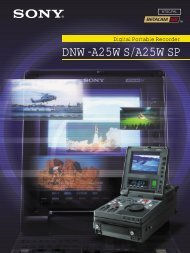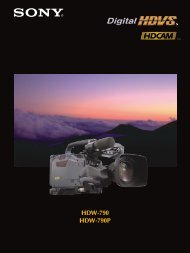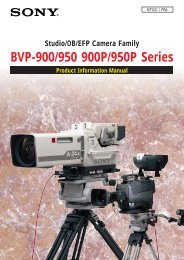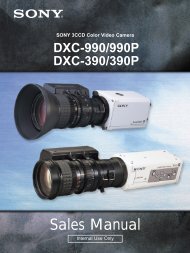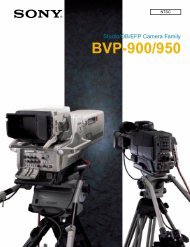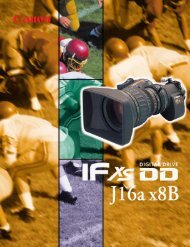Specifications †Optional System AccessoriesOVERALL SYSTEMOperating FrequencyFrequency Stability<strong>VHF</strong> high band, 169.505 to 213.800 MHz±0.005%, single-frequencycrystal-controlledFM±30 kHz, traveling frequencies ±15 kHz200' minimumModulation ModeMaximum Deviation RangeOperating RangeOperating Temperature Range 41° F (5° C) to 113° F (45° C)Frequency Response100 Hz to 15 kHzRECEIVERReceiving SystemImage RejectionSignal-to-noise RatioTotal Harmonic DistortionSensitivityIntermediate Frequency<strong>Audio</strong> OutputUnbalanced:Balanced:Output ConnectorsPower SupplyDimensionsWeightAccessories IncludedUNIPAK TRANSMITTERRF Power OutputSpurious EmissionsDynamic RangeInput ConnectionsBatteryCurrent ConsumptionBattery LifeDimensionsNet Weight (without battery)Dual independent receivers, automaticswitching diversity reception≥ 60 dB112 dB at 30 kHz deviation(IEC-weighted), maximum modulation75 kHz≤1% (10 kHz deviation @ 1 kHz)5.6 µV for 60 dB S/N (IEC-weighted)10.7 MHz100 mV (at 1 kHz, ±5 kHz deviation,10k ohm load)31.6 mV (at 1 kHz, ±5 kHz deviation,10k ohm load)Unbalanced: 1 /4" phone jackBalanced: XLRM-type120V AC 60 Hz; or 12-18V DC,350 mA, with external supply8.27" (210.0 mm) W x 1.93" (49.0 mm) Hx 8.86" (225.0 mm) D3.9 lbs (1.8 kgs)Two whip antennas, rack mount adapters50 mW MaxUnder federal regulations≥90 dBHigh impedance, low impedance, bias9V (NEDA type 1604) alkaline, not included35 mA typicalApproximately 10 hours (depending onbattery type and use pattern)2.40" (61.0 mm) W x 4.23" (107.4 mm) Hx 1.08" (27.5 mm) D2.8 oz (78 grams)HANDHELD TRANSMITTERRF Power Output50 mW MaxSpurious EmissionsUnder federal regulationsDynamic Range≥90 dBMicrophone ElementATW-T36HEA-T Hi-ENERGY ® dynamic hypercardioidATW-T37CA-T condenser hypercardioidBattery9V (NEDA type 1604) alkaline, not includedCurrent Consumption35 mA typicalBattery LifeApproximately 10 hours (depending onbattery type and use pattern)DimensionsATW-T36HE9.27" (235.5 mm) long,1.49" (37.9 mm) body dia.ATW-T37C9.38" (238.3 mm) long,1.46" (37.1 mm) body dia.Net Weight (without battery)ATW-T36HE8.6 oz (245 grams)ATW-T37C7.2 oz (204 grams)Accessory IncludedStand clamp† In the interest of standards development, A.T.U.S. offers full details on its test methodsto other industry professionals on request.MICROPHONES AND CABLESAT829cW AT829 miniature cardioid condenser microphone only,terminated for use with UniPak transmitter. Includesclothing clip and windscreen.MT830cW MT830R subminiature omnidirectional condensermicrophone only, terminated for use with UniPaktransmitter. Includes clothing clip and windscreen.MT830cW-TH ”Theater“ model, same as MT830cW except beige colormic and cable for concealment.AT831cW AT831b miniature cardioid condenser microphone only,terminated for use with UniPak transmitter. Includesclothing clip and windscreen.AT851cW AT851a surface-mount wide-range hemi-cardioidcondenser microphone only, terminated for use withUniPak transmitter.AT857AMLcW AT857AMLa 19" gooseneck cardioid microphone only,terminated for use with UniPak transmitter. Mounts to5/8"-27 thread. Includes windscreen.AT889cW Headworn noise-canceling condenser microphone only,terminated for use with UniPak transmitter. Includeswindscreen and cable clip.ATM35cW ATM35 high-intensity miniature cardioid condensermicrophone only, terminated for use with UniPaktransmitter. Includes AT8418 clip-on instrument mount.ATM73cW ATM73a headworn cardioid condenser microphone only,terminated for use with UniPak transmitter.ATM75cW ATM75 headworn cardioid condenser microphone only,terminated for use with UniPak transmitter. Includeswindscreens and cable clip.PRO 8HEcW PRO 8HEx headworn hypercardioid dynamic microphone,terminated for use with UniPak transmitter. Includeswindscreen and cable clip.PRO 35xcW PRO 35x cardioid condenser microphone only, terminatedfor use with the UniPak transmitter. Includes AT8418clip-on instrument mount.AT-GCW Hi-Z instrument/guitar cable with 1 /4" phone plug,terminated for use with UniPak transmitter.XLRW Connecting cable for UniPak transmitter with an XLRF-typeinput connector, for Lo-Z microphones with XLRM-typeoutput terminations.TRANSMITTER ACCESSORIESATW-VP10 Vinyl pouch with belt clip to hold UniPak transmitter.AT8114 Foam windscreen for handheld transmitter.AT8141 Water-resistant pouch for UniPak transmitter.AT8431 Stand clamp for handheld transmitter, 5 /8"-27 threads.AT8456 Stand clamp for handheld transmitter, 5 /8"-27 threads.INTERCHANGEABLE ELEMENTS (for use with ATW-T37C transmitter)AT853C-ELE Cardioid element.AT853H-ELE Hypercardioid element (included).AT853O-ELE Omnidirectional element.AT853SC-ELE Subcardioid element.RECEIVER ACCESSORIESAT8628 Mounting plate adapter allows rack-mounting twoATW-R12 receivers side-by-side in a single 19" rack space.ATW-A10 Pair of <strong>VHF</strong> ground-plane antennas with 5 /8"-27 thread formounting to microphone stands, etc. Takes RF cables withPL259 connectors, not included.ATW-D12a Active, unity-gain <strong>VHF</strong> antenna distribution systemprovides two “1-in, 4-out” amplifier/splitters; connects apair of antennas to as many as four diversity receivers.Includes two antennas, two input cable adapters and eightoutput cables.ATW-RA1 Rack-mount antenna kit brings antenna inputs to the frontof receiver for ease of setup, or when receiver is enclosedin a metal rack. Includes a pair of extendible antennas.NOTE: Two adapter kits are required when mountingtwo receivers side-by-side in a single 19" rack space.6
<strong>Wireless</strong> Operating FrequenciesFrequency SelectionEach transmitter/receiver system operates on a single factoryaligned,crystal-controlled frequency. Available frequencies areshown in the chart below.Operating frequency is specified by a two- or three-charactercode, such as “T2” or “11G,” in addition to the actualfrequency in MHz. The frequency of each transmitter appearson a label on the outside of the unit. The frequency of eachreceiver appears on a label on the back of the unit and thefrequency of each system appears on the outer carton. Forfuture reference, please record them in the space provided.Because most of these authorized frequencies are sharedwith TV broadcasting, frequency selection is largely dependentupon which TV broadcast channels are in operation wherethe wireless system is to be used.RF InterferenceIf you encounter receiving interference (from other than anoperating TV station), often it can be eliminated by adjustingthe receiver’s squelch control, as described on page 5.Please note that wireless frequencies are shared with otherradio services. According to Federal CommunicationsCommission regulations, “<strong>Wireless</strong> microphone operationsare unprotected from interference from other licensed operationswithin the band. If any interference is received by anyGovernment or non-Government operation, the wirelessmicrophone must cease operation…”If you need assistance with operation or frequency selection,please contact your dealer or the A-T professional division.Extensive wireless information also is available on the A-TWeb site at www.audio-technica.com.System Operating FrequenciesApplication Freq. Code Freq. (MHz)• Traveling frequencies: T2 169.505(Normally work anywhere in the U.S.A. and Canada, T3 170.245but as a result tend to be crowded.) T8 171.905• For use only where there is no TV Channel 7: 7G 175.8007I 176.200• For use only where there is no TV Channel 8: 8D 181.2008M 183.2008S 184.200• For use only where there is no TV Channel 9: 9F 187.6009Q 189.800• For use only where there is no TV Channel 10: 10C 193.00010J 194.40010W 196.800• For use only where there is no TV Channel 11: 11G 199.80011S 202.200• For use only where there is no TV Channel 12: 12L 207.00012S 208.20012V 208.600• For use only where there is no TV Channel 13: 13B 210.80013Q 213.800Multi-channel <strong>Systems</strong>Following are groupings of frequencies suggested for multi-channel wireless systems.• For use where TV channels 7, 9, 11 and/or 13 are operating: 8D-8M-8S-10C-10J-10W-12L-12S-12VTraveling frequencies T2, T3 and/or T8 may be used with any of the above frequencies except for: 8D,8M and 10C. Interference may result from the use of these frequency combinations.• For use where TV channels 8, 10 and/or 12 are operating: 7G-7I-9F-9Q-11G-11S-13Q or7G-7I-9F-11G-11S-13B-13QTraveling frequencies T2, T3 and/or T8 may be used with any of the above frequencies with nointerference problems.For future reference, please record your system information here (the serial numbers appear insidethe battery compartment of each transmitter, and on the bottom of each receiver):Operating FrequencyFreq. Code Frequency MHzReceiverModelSerial NumberTransmitterModelSerial Number7



